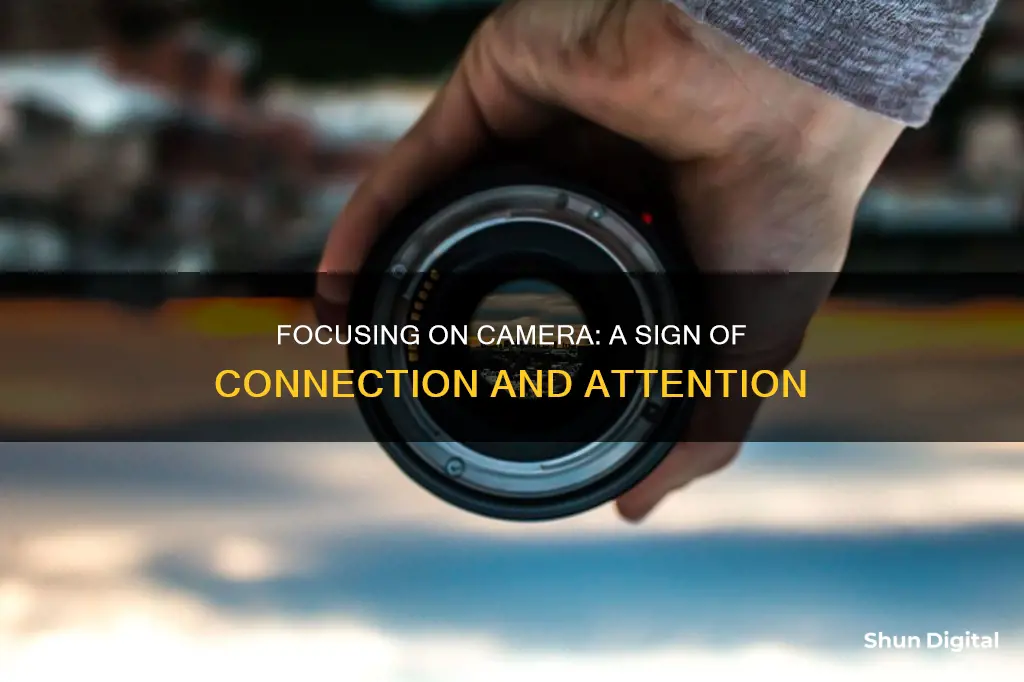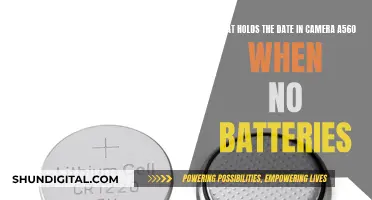
Focusing is a crucial aspect of photography, ensuring that the desired area of the image is in sharp focus. The focus can be adjusted manually by turning the lens' focus ring, or automatically by the camera's autofocus system. The autofocus system uses either phase detection or contrast detection to determine the correct focus. Phase detection is faster and better suited for tracking moving objects, while contrast detection is more accurate and commonly used in mirrorless cameras and smartphones. The focus mode can be set to single-shot, continuous, or automatic, depending on the subject and photography style. Different lenses, such as fisheye, wide-angle, normal, telephoto, and macro, also play a role in achieving the desired focus and composition.
| Characteristics | Values |
|---|---|
| Purpose | To highlight an object, person, or situation |
| Control | Automatic or manual |
| Manual focus | Turn the lens' focus wheel |
| Automatic focus | Camera adjusts focus in response to incoming light |
| Autofocus types | One Shot, AI Focus, Autofocus S, Single AF |

Manual vs Autofocus
Manual focus and autofocus are two different ways of achieving the same goal: a clear shot. The main difference is that autofocus allows the camera to set the focal point, while manual focus enables the user to set the focal point.
Autofocus
Autofocus is generally faster than manual focus, although its speed depends on the camera and lens type. Sports-oriented equipment, for example, is typically much faster. Autofocus has seen advancements such as tracking, which enable it to lock focus on a subject and track it through the frame. This feature is particularly useful for capturing moving subjects.
Autofocus systems rely on contrast to identify objects of interest. When this contrast is not present, such as in low-light conditions or when shooting through glass or fences, autofocus may struggle. Autofocus can also be confused by scenes with many objects, as it tends to focus on foreground objects.
Manual Focus
Manual focus offers greater creative control as the user determines the focus point. It is ideal for situations where autofocus may struggle, such as in low-light conditions or when there are many objects in the scene. Manual focus is also more precise, allowing the user to carefully pick the point of focus from a chaotic scene.
Manual focus is generally slower than autofocus, making it less suitable for capturing moving objects. It also requires the photographer to choose the point of focus, which can be challenging in certain situations.
When to Use Autofocus
Autofocus is recommended when photographing wildlife on the move, birds in flight, street photography, or pets at play. It is also useful when working alone or when starting out in photography or filmmaking, as it allows you to concentrate on other elements such as exposure and lighting.
When to Use Manual Focus
Manual focus is recommended for macro photography, deep landscape photography, complex focus bracketing, scenes with many distracting foreground elements, and low-light conditions. It is also useful when you need to nail a precise point of focus that the camera struggles with, such as portraits.
The choice between manual focus and autofocus depends on the photographer's needs and shooting conditions. Neither is universally superior, and photographers should be familiar with both methods.
Mastering Auto Focus for Cinematic Camera Work
You may want to see also

Autofocus Modes
Autofocus, or AF, is when the camera system drives a motor to move elements in your lens to change focus. There are several autofocus modes available on modern cameras, and they are useful in different situations. Here are some of the most common autofocus modes:
- AF-S (Auto Focus Single Shot): This mode is suitable for photography where the subject isn't moving. The camera locks the focus point when you half-press the shutter button. If you move the camera, it will not continue to hunt for focus but will stay locked.
- AF-C (Auto Focus Continuous): This mode is ideal for photographing moving subjects, such as wildlife, sports, or portraits. The camera will continue to hunt for focus as long as you hold the shutter button halfway down, even if you move the camera or the subject moves.
- AF-A (Auto Focus Automatic): This mode allows the camera to automatically switch between AF-S and AF-C, depending on whether the subject is stationary or moving. It is a good choice if you are unsure which mode to use, but the camera may struggle in low-light conditions.
- DMF (Digital Manual Focus): This mode blends manual focusing with automatic focusing. You can lock the focus by half-pressing the shutter button and then refine the focus manually by turning the focus ring. DMF is useful in low-light conditions or when you want more control over the focus.
- Manual Focus: Manual focus is useful when the camera struggles to autofocus, such as in low-light conditions or when there is little contrast in the scene. It is also beneficial if you want to save battery life. However, manual focus is slower than autofocus modes and requires more precision from the photographer.
Colorado Camera Tickets: Do You Have to Pay?
You may want to see also

Focus Settings
Focus is one of the most important pillars of photography. It is the sharpest area of the image, where the lens works to highlight an object, person, or situation. Photographers can choose to use autofocus or manual focus.
Autofocus
Autofocus is a setting that makes the focusing process easier, especially for beginners or those who want to experiment with a type of photography that requires more speed. The camera system drives a motor to move elements in the lens to change focus. Most photographers use autofocus more often than manual focus because it is more convenient and tends to be faster and more accurate.
There are two types of autofocus systems: phase detection and contrast detection. Phase detection is very fast and good at tracking moving subjects, but it is more prone to errors and internal misalignment issues. Contrast detection, on the other hand, requires the camera to process more data and generally takes longer to lock focus, but it tends to be more precise.
Different autofocus modes include:
- Single-servo autofocus (also known as One-Shot or AF-S), where the camera acquires focus and doesn't readjust until you let go of the focusing button.
- Continuous-servo autofocus (also known as AI Servo or AF-C), where the camera continuously adjusts focus as long as you hold down the focusing button.
- Auto-servo autofocus, which analyzes the scene and automatically picks between single-servo and continuous-servo.
Manual Focus
Manual focus is when the photographer manually sets the focus by turning the focus ring of the camera. This is useful when the camera has difficulty focusing or when taking a series of images where you don't want the focus to change. Manual focus lets you override any issues and make precise adjustments.
To focus manually, you need to turn a ring or similar mechanism on the lens. This can be useful when your camera is having trouble focusing, such as in dark conditions, or when you want to lock focus for a series of photos in a row.
Charging Night Owl Cameras: A Step-by-Step Guide
You may want to see also

Focus Area Modes
Autofocus area modes are a crucial part of focusing in photography. They allow you to fine-tune how and where your camera focuses within a scene. The right autofocus area mode, combined with the right focus mode, can help you nail your autofocus and take sharper photos.
There are several autofocus area modes available in modern DSLR and mirrorless cameras. Here are some of the most common ones:
- Single-Point Autofocus Mode: This mode allows you to select a single focus point for static elements within the scene. As long as you keep the subject framed over this point and are using continuous autofocus, the camera will automatically adjust the focus to keep the image sharp. This mode is ideal for still subjects or scenes where the focus point is crucial, such as landscape and portrait photography.
- Dynamic AF Area Mode: With this mode, you manually select a focus point, and if the subject moves, the camera uses this point and the surrounding points to keep the subject sharp. This mode is well-suited for wildlife and sports/action photography, where the subject is in motion.
- Group AF Area Mode: This mode lets you select a specific autofocus area with multiple autofocus points to focus on a particular subject or zone. It is useful for wildlife and sports photography, where there are multiple subjects in a group within a specific area.
- Auto AF Area Mode: In this fully automatic mode, the camera decides which focus points to use based on factors like subject distances, motion relative to the camera, and the presence of detectable eyes. It is suitable for novice photographers or situations where you need to focus quickly on something close to the camera. However, it may not be ideal when you need more control over the focus point.
Different camera brands may have slightly different names for these autofocus area modes. For example, Nikon refers to Single-Point AF as "Single-Point AF," while Canon calls it "Manual AF Point." It's important to refer to your camera's instruction manual to understand the specific autofocus area modes available and how to use them effectively.
Avoid Camera Tickets: Tips to Keep Your Record Clean
You may want to see also

Focus Lock
Manual focus is when the photographer manually adjusts the focus ring of the camera. It is less commonly used than autofocus, but it is particularly useful when the camera struggles to focus or when taking a series of images where focus should remain constant.
Autofocus, on the other hand, is a mechanism that automatically moves the elements within the lens to achieve the best focus. This is done through a series of autofocus points that are visible through the viewfinder. The photographer or the camera can select a particular focus point to achieve focus.
There are two ways in which cameras can automatically select a focus point: Phase Detection and Contrast Detection. Phase Detection is commonly found in DSLR cameras and is very fast, making it great for tracking moving objects. Contrast Detection, on the other hand, is commonly used in mirrorless cameras, point-and-shoot cameras, and DSLRs in live view mode. It is slower but more accurate, making it better suited to genres like product or landscape photography.
Different cameras have different focus systems and focus points. Depending on the focus mode chosen, either the camera or the photographer can choose the best point of focus. Some modern-day cameras also feature eye detection, which can be very useful as the eyes are often the best place to focus.
When using autofocus, there are several modes to choose from, each better suited to particular scenarios. Single-shot/Single-servo focus mode uses only one focus point to determine focus, which does not change until the photographer refocuses. Continuous focusing/Continuous-servo, on the other hand, continuously monitors the distance of the subject from the camera and readjusts as necessary for as long as the focus button is held down.
Georgia's Camera Ticket Policy: What You Need to Know
You may want to see also
Frequently asked questions
To direct the camera's attention to the desired object.
Focus is critical to getting a good photograph. It ensures that a part of the image is sharp and highlights the intended object, person, or situation.
There are two main types of focus: automatic and manual. In automatic mode, the camera adjusts the focus based on incoming light to make the subject appear sharp. In manual mode, the photographer turns the lens' focus wheel to bring the desired subject into focus.







